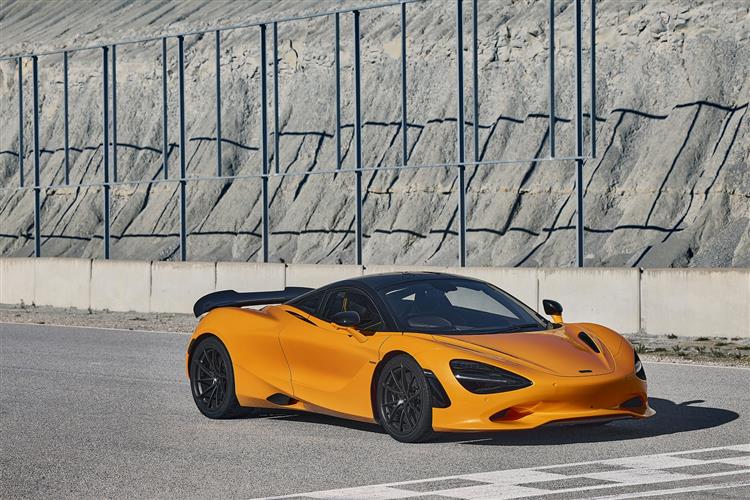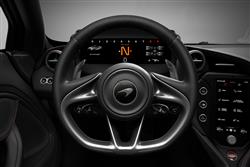POWERPLAY (some text hidden) --NONE--
By Jonathan Crouch
The McLaren 750S claims to be the segment's most complete supercar. Jonathan Crouch drives it.
Ten Second Reviewword count: 59
The McLaren 750S takes the basic formula of its 720S predecessor and tweaks the suspension, increases the aerodynamic downforce, ups the power, improves the styling and smartens the cabin. The result is arguably the segment's most complete supercar. More capable, more compliant and more complete than anything the brand has previously brought us, there's nothing else quite like it.
Backgroundword count: 171
In its own small but significant way, McLaren is redefining the ultimate end of the exotic sportscar market. And here's proof, in the form of one of the most important models this British brand has ever made - the 750S. It's the company's mid-range 'Supercar' model, a replacement for the 720S launched back in 2017. The Woking maker's 'Sports Series' GTS model sits just below this car. And the rare and exclusive 'Ultimate Series' McLaren Senna, Elva and Speedtail models are positioned just above it. The 720S was a decent step on from its 2014-era 650S predecessor, delivering near hypercar speed for near-supercar money. As its name suggests, the 750S is an evolution, but a surprisingly comprehensive one. It aims to redefine just how fast a road car can be - while still continuing to be credible form of conveyance, rather than a racer with a reg plate. In many ways, it's McLaren's most definitive car. And it hopes to involve and satisfy you in a way that no competitor can.
Driving Experienceword count: 316
Bucking the segment trend, there's no complex Hybrid engine here, but lots is still new. A power hike obviously - as the model name suggests, up from 720 to 750PS. And a 30kg weight saving, creating the lightest series production McLaren road car yet (without fluids, it tips the scales at just 1,326kg, around 300kgs lighter than a rival Ferrari 296 GTB). Subtle changes have also been made to the M840T twin turbocharged 4.0-litre V8 out back, including revised calibration for sharper power delivery, high-pressure turbos and lighter pistons. Plus there's a (15%) shorter final drive ratio for the 7-speed dual-clutch paddleshift automatic gearbox. The result of all this is a segment-leading power-to-weight ratio of 587PS-per-tonne; 800Nm of torque (30Nm more than with the 720S). And a 0-62mph figure of just 2.8s (10% faster than before), with 186mph crested 4.4s later, before (perhaps on the Hanger Straight at Silverstone or very bravely on a derestricted autobahn), you top out at 206mph. So it's very fast: but then you knew it would be. As before, you control the Powertrain via three selectable settings - 'Comfort', 'Sport' and 'Track'. Which are also your settings for the upgraded Handling system, improved here with extensive chassis revisions, a faster steering rack and an enhanced version of the brand's clever Proactive Chassis Control system, which limits body roll. There's also a 6mm increase in front track width and lighter springs (which are 4% stiffer at the rear and 3% stiffer at the front). The engine mounts have been modified to give what McLaren calls 'an intensified sense of connection'. And, perhaps best of all, the crackling standard-fit sports exhaust sounds even wilder, furiously spewing noise and gas upwards as the turbos chirp and whistle. Roof-down in this Spider model, it's an astonishingly emotive sound and you can hear it brilliantly even without the roof down, simply by retracting this rear window.
To see the full road test text contact us on 0330 0020 227
Pictures (high res disabled)

.jpg)
|
.jpg)
|
.jpg)
| |||
.jpg)
|
.jpg)
|
.jpg)
| |||

|
Statistics (subset of data only)
Min |
Max |
|
Price: |
£251,000.00 (At 6 Mar 2025, Coupe) |
£276,000.00 (At 6 Mar 2025, Spider) |
Insurance group 1-50: |
50 |
|
CO2 (g/km): |
276 |
|
Max Speed (mph): |
212 |
|
0-62 mph (s): |
2.8 |
|
Combined Mpg: |
23.2 |
|
Length (mm): |
4569 |
|
Width (mm): |
1930 |
|
Height (mm): |
1196 |
|
... and 3 other stats available | ||
Scoring (subset of scores)
Category: Sporting Cars
| Performance | |
| Handling | |
| Comfort | |
| Space | |
| Styling, Build, Value, Equipment, Depreciation, Handling, Insurance and Total scores are available with our full data feed. | |



